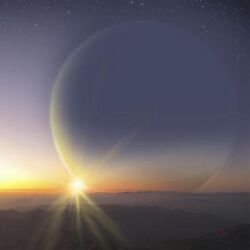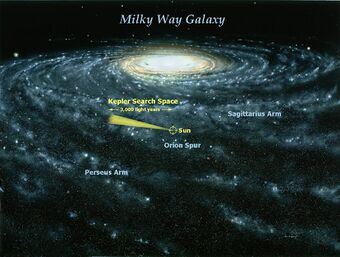Astronomy:Kepler-86
| Observation data Equinox J2000.0]] (ICRS) | |
|---|---|
| Constellation | Cygnus[3] |
| Right ascension | 19h 19m 03.2634s[4] |
| Declination | 51° 57′ 45.4105″[4] |
| Characteristics | |
| Spectral type | G5V[5][note 1] |
| Apparent magnitude (J) | 11.501±0.023[2] |
| Apparent magnitude (H) | 11.182±0.03[2] |
| Apparent magnitude (K) | 11.116±0.022[2] |
| Apparent magnitude (B1) | 12.34[2] |
| Apparent magnitude (R1) | 12.62[2] |
| B−V color index | 0.072[5] |
| Astrometry | |
| Proper motion (μ) | RA: 3.366±0.053[4] mas/yr Dec.: 16.026±0.061[4] mas/yr |
| Parallax (π) | 2.8796 ± 0.0302[4] mas |
| Distance | 1,130 ± 10 ly (347 ± 4 pc) |
| Absolute bolometric magnitude (Mbol) | 5.01+0.12 −0.12[6][note 2] |
| Details | |
| Mass | 0.94±0.02[7] M☉ |
| Radius | 1.00±0.05[7] R☉ |
| Luminosity (bolometric) | 0.79+0.09 −0.08[7] L☉ |
| Surface gravity (log g) | 4.408±0.044[7] cgs |
| Temperature | 5629+42 −45[7] K |
| Metallicity [Fe/H] | −0.07±0.05 dex |
| Rotational velocity (v sin i) | 1.43±0.08 km/s |
| Other designations | |
| Database references | |
| SIMBAD | data |
| KIC | data |
Kepler-86, PH2[1] or KIC 12735740 (2MASS 19190326+5157453), is a G-type star[7][note 1] 1,130 ly (350 pc) distant[4] within the constellation Cygnus.[3] Roughly the size and temperature[5] of the Sun,[8] PH2 gained prominence when it was known to be the host of one of 42 planet candidates detected by the Planet Hunters citizen science project in its second data release.[9] The candidate orbiting around PH2, known as PH2 b, had been determined to have a spurious detection probability of only 0.08%, thus effectively confirming its existence as a planet.[7]
Located in its parent star's habitable zone, PH2 b (or Kepler-86b[1]) is a "Jupiter-size" gas giant which may have a natural satellite suitable for hosting life.[9] The report of the confirmed detection of PH2 b was submitted on January 3, 2013.[7] It was discovered by amateur Pole Rafał Herszkowicz using his laptop and access to the Internet project with data from the Kepler space observatory.[10]
History of detection
PH2 b was detected, along with 42 other planet candidates, in archival data from Kepler by the Planet Hunters project, in which human volunteers analyze the light curves of Kepler target stars, searching for planetary transit signals which may be missed by computer programs.[7] Previous work by Planet Hunters helped to confirm the existence of PH1 b, a Neptune-mass planet within a four-star system.
All of the candidates in the second, including PH2 b, were identified by citizen scientists Abe J. Hoekstra, Thomas Lee Jacobs, Daryll LaCourse, Hans Martin Schwengler, Rafał Herszkowicz and Mike Chopin among others, with the help of Yale University astronomers.[7] In addition to PH2 b itself, twenty other planet candidates were found which are located in the habitable zones of their host stars; however, these have a relatively high probability of spurious detection and may well come from non-planetary sources.[7]
Although the planet's initial detection was made using Kepler data, PH2's stellar spectra, required to rule out background stars or faint companions with planets as sources for the observed transits, were collected using the HIRES instrument at the W. M. Keck Observatory.[7] Results of observations confirmed the existence of PH2 b with "99.9 percent confidence."[7][9]
Planetary system
PH2 is host to one confirmed planet, PH2 b, orbiting with a period of about 282 days, placing it and any possible moons in the habitable zone.[9] The temperature in the upper atmosphere of the planet could range from 185 K (−88 °C; −127 °F) to 303 K (30 °C; 86 °F).[7] A moon of PH2 b would likely have "a rocky core, plus a greenhouse atmosphere of some sort that could have liquid water on its surface" in the words of the researchers, thus further improving its prospects for habitability.[9]
| Companion (in order from star) |
Mass | Semimajor axis (AU) |
Orbital period (days) |
Eccentricity | Inclination | Radius |
|---|---|---|---|---|---|---|
| b | — | 0.828±0.009 | 282.5255±0.0010 | 0.41+0.08 −0.29 |
89.83+0.03 −0.02° |
10.12±0.56 R⊕ |
See also
Notes
References
- ↑ 1.0 1.1 1.2 Staff (September 25, 2013). "Congratulations! MT @planethunters: Our 2nd confirmed planet PH2 b has received the alternate Kepler designation of Kepler-86b.". inagist/@NASAKepler. http://inagist.com/all/382705708380073984/.
- ↑ 2.0 2.1 2.2 2.3 2.4 2.5 "Gator Cone Search Result". The Two Micron All Sky Survey at IPAC. NASA/IPAC. http://irsa.ipac.caltech.edu/workspace/TMP_7aNmhU_31885/Gator/irsa/3547/tbview.html.[yes|permanent dead link|dead link}}]
- ↑ 3.0 3.1 "VizieR Detailed Page". VizieR. Harvard-Smithsonian Center for Astrophysics. http://vizier.cfa.harvard.edu/viz-bin/VizieR-5.
- ↑ 4.0 4.1 4.2 4.3 4.4 4.5 Brown, A. G. A. (August 2018). "Gaia Data Release 2: Summary of the contents and survey properties". Astronomy & Astrophysics 616: A1. doi:10.1051/0004-6361/201833051. Bibcode: 2018A&A...616A...1G. Gaia DR2 record for this source at VizieR.
- ↑ 5.0 5.1 5.2 "Kepler Data Search Results". MAST. Space Telescope Science Institute. http://archive.stsci.edu/kepler/data_search/search.php?action=Search&ktc_kepler_id=12735740.
- ↑ Mamajek, Eric (December 30, 2012). "Basic Astronomical Data for the Sun (BADS)". University of Rochester. http://www.pas.rochester.edu/~emamajek/sun.txt.
- ↑ 7.00 7.01 7.02 7.03 7.04 7.05 7.06 7.07 7.08 7.09 7.10 7.11 7.12 7.13 7.14 Wang, Ji (January 3, 2013). "Planet Hunters. V. A Confirmed Jupiter-Size Planet in the Habitable Zone and 42 Planet Candidates from the Kepler Archive Data". arXiv:1301.0644v1 [astro-ph].
- ↑ Williams, David R. (March 2, 2012). "Sun Fact Sheet". National Aeronautics and Space Administration. http://nssdc.gsfc.nasa.gov/planetary/factsheet/sunfact.html.
- ↑ 9.0 9.1 9.2 9.3 9.4 Howell, Elizabeth (11 January 2013). "Amateur Astronomers Discover 42 Alien Planets". Space.com. Space.com. http://www.space.com/19233-amateurs-discover-alien-planets.html.
- ↑ "Polski informatyk Rafał Herszkowicz odkrył nową planete PH2b | Forsal.pl - Giełda, Waluty, Finanse" (in pl). Forsal. 2013-03-27. http://forsal.pl/artykuly/693169,polski_informatyk_rafal_herszkowicz_odkryl_nowa_planete_ph2b.html.
Footnotes
External links
- Kepler Mission - NASA.
- KIC-12735740 Star on Star Finder/cthreepo[yes|permanent dead link|dead link}}]
- Video (00:52) - Journey To Exoplanet "PH2 b"




